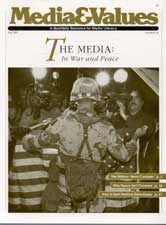Why Peace Isn't Covered
|
This article originally appeared in Issue# 56
|
An Interview With Sam Keen
To many, the Persian Gulf War was a tragedy, to others a successful crusade. To Sam Keen, the writer, teacher and scholar of religion who wrote Faces of the Enemy: Reflections of the Hostile Imagination, and Fire in the Belly: On Being a Man, it was the latest example of the age-old fallacy of projecting our "shadow side" onto a mostly unknown, faceless enemy. M&V editor Rosalind Silver interviewed Keen about the images that shape war, peace and the media's role in creating them.
M&V: Can you explain what you mean by "the hostile imagination?"
Keen: We first kill people with our minds, before we kill them with weapons. Whatever the conflict, the enemy is always the destroyer. We're on God's side; they're barbaric. We're good, they're evil. War gives us a feeling of moral clarity that we lack at other times.
M&V: What part does the media play in this process?
Keen: It's not always recognized but media play a dual role in the creation of war images, at times propagandistic and at other times prophetic. For example, the cartoonists' recent ratlike images of Hussein and Noriega join a long line of enemy-as-vermin cartoons going back to World War I or even earlier. But other cartoonists were critical from the beginning and played a prophetic role in questioning the Gulf War. This isn't new, but television has changed things. Its rapid-fire images help to create a Superbowl atmosphere that puts viewers into a high alpha, dreamlike state that blocks out almost all thought. In the Gulf War this promoted the Nintendo-game atmosphere that made the ultimate dehumanization possible-turning the enemy into a number, a blip on the radar screen. Instead of a bloody conflict we have a triumph of American technology.
"There will always be conflicts between persons and nations,
but no gene condemns us to dehumanize or destroy those with whom we differ."
-- Sam Keen, Faces of the Enemy
M&V: How susceptible are we to deliberate manipulation?
Keen: In some ways I think we're more susceptible than a less media-attuned country. In a semi-literate country like Nicaragua the message is pretty much limited to posters. But we have to beware of thinking we're too smart to have the wool pulled over our eyes. To me much of the imagery before and during the Gulf War seemed like conscious manipulation by a president who welcomed an enemy as a distraction from a depressed economy and domestic troubles.
M&V: Any changes since the war ended?
Keen: While a war is going on it's like the Wizard of Oz working the illusion. We may be able to see the levers, but until it stops we're still fascinated. As soon as the "war-gasm" is over we can ask questions again. Now, even Time magazine is asking, "Was it worth it?"
M&V: How can we prevent getting to this state in the future?
Keen: Ultimately, our views of heroism, masculinity, relationships between men and women and what constitutes a worthwhile life will have to change. Instead of being propagandistic the media should be our guides and conscience in this process. We need them in their role as prophets to be both a form of collective memory and a fair witness as we struggle to reshape our society. But before this process can happen, Americans have to reexamine our continual quest for innocence-a kind of perpetually-renewing virginity. Unless we do, we'll continue to be stuck in what I call the High Noon road to the unconscious. It's hard to step out of the showdown long enough to learn that the road to good and evil runs down the middle of our own souls.



